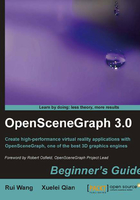
Foreword
Scene graphs have been the foundation of real-time graphics applications for the last two decades, whether it is a 3D game on a phone or a professional flight simulator costing millions of pounds, a virtual reality application through to the latest 3D real-time visualization on television, scene graphs are there under the hood, quietly churning out high quality visuals.
However, even powerful tools like scene graphs don't write world leading graphics applications by themselves, they still need developers with the skill and knowledge to make best use of them and the hardware that they run on. This expertise isn't something that you can gain by reading a few pages on the web—graphics hardware and software continues to evolve and you need to keep up with it... It's a journey of learning and exploration undertaken throughout your career.
OpenSceneGraph itself is the world's leading scene graph API, and has been written by, and to fulfil the needs of, professional graphics application developers. It is written to be powerful and productive to use rather than cut down and easy to use. Your first encounter with OpenSceneGraph may well be daunting; it's a professional grade scene graph containing many hundreds of classes and modules. But with this sophistication comes the ability to write very powerful graphics applications quickly so it's well worth the effort in learning how to make best use of it.
The authors of this book are users and contributors to the OpenSceneGraph software and its community. For me it's rewarding to see this open source project reach out across the world and inspire people, such as Rui Wang and Xuelei Qian, not only to use and contribute to the software, but also to write a book about it so that others can start their own journey into real-time graphics.
With this book their aim has been to take you from your first steps through to being able to use advanced features of the OpenSceneGraph and the graphics hardware that it runs on. Learning new concepts and APIs can often be dry and awkward, but once you get your first applications on screen you'll glimpse the potential, and it won't be long before you are seeing complex worlds come life. As a real-time graphics geek myself, I can't think anything more rewarding than immersing yourself in 3D worlds that you help create. Some familiarity with linear algebra, such like 3D vectors, quaternion numbers and matrix transformations, is helpful, too.
Robert Osfield.
OpenSceneGraph Project Lead